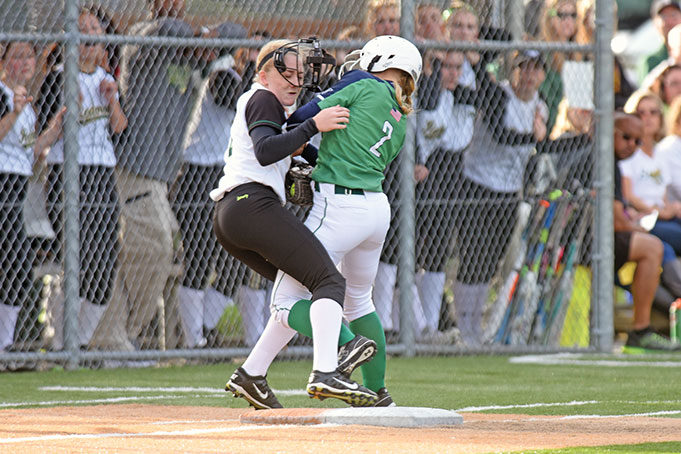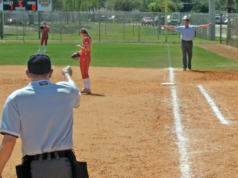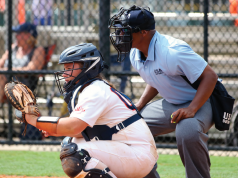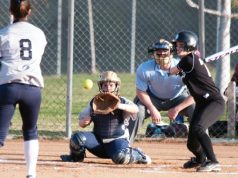Collisions on the basepaths are not a routine occurrence in fast-pitch softball, so it is important for umpires to prepare for scenarios that can unfold quickly.
Not every collision involves a rules violation, so umpires must be able to differentiate between plays involving incidental contact and intentional contact. Beyond that, umpires must be alert to the possibility that intentional contact sometimes exceeds what is reasonable in the heat of competition and results in a flagrant act that warrants ejection of the offender.
The various fast-pitch organizations have similar rules regarding a collision between a runner and a fielder. The key to making the correct ruling is based on an understanding of the rules for interference and obstruction, which cover situations involving contact between offensive and defensive players.
The USA Softball Umpire Manual offers useful guidelines for handling collisions:
“Contact between defensive and offensive players does not necessarily mean that obstruction or interference occurred. … Consider the following: Did the offensive player alter their direction in a way to draw contact with the defensive player in an attempt to draw an obstruction call? Did the defensive player alter their attempt to field the ball to draw an interference call? Could the defensive player actually make a play? Did the defensive player have possession of the ball?”
Understand the rules for interference and obstruction
In each code, a runner is not allowed to remain on her feet and crash into a fielder in possession of the ball. When this situation occurs, interference should be ruled. The runner involved in the collision is called out, any other runners must return to the last base touched at the time of the collision (unless forced to advance), and the batter-runner is awarded first base.
However, umpires should watch the play develop and finish in case the contact is severe, then be prepared to rule accordingly. The NFHS code includes a definition of malicious contact — “an act that involves excessive force with an opponent.” The penalty is ejection for the offender.
A sign that excessive force might be involved is when the fielder holding the ball ends up on the ground. For example, a runner who remains on her feet and forcefully pushes the fielder with both hands should be ejected in most cases. But what if the runner was slowing down as she approached the fielder and reached out with both arms to grasp her in an attempt to minimize the impact, yet both players lost their balance and ended up on the ground? In this situation, while it is impossible to determine a player’s intent, an umpire watching the play develop and finish could justifiably rule that the contact was not malicious or flagrant.
It is important to realize that malicious or flagrant contact also can be caused by the defense, which is why umpires should watch tag plays as closely as possible. Consider the situation of a runner on first base advancing to second base on a ground ball. After fielding the ball, the second baseman uses unnecessary force in tagging out the runner. As long as the fielder retains possession of the ball, the runner is out. But if the fielder does not have possession of the ball at the time of the collision, obstruction should be called and the runner is awarded the base the umpire judges she would have otherwise reached. In both situations, the second baseman should be ejected for malicious contact.
Anytime there is a possibility of a throw to home plate, the plate umpire should be prepared for a collision. Several situations could develop: the catcher might attempt to block the plate as the runner approaches, the runner could decide to remain on her feet because she thinks she will beat the throw, or the catcher might try to make a throw to retire another runner after the lead runner has touched the plate.
If the catcher is blocking the plate without possession of the ball and the runner makes contact with the catcher before touching the plate, obstruction should be called and the runner is awarded home plate. This would be the ruling even if the runner pushes the catcher out of the base path, as specified in the NFHS softball casebook. If the runner’s push was malicious, however, she would be ejected and the run would not count. NFHS specifies that malicious contact supersedes obstruction, as does USSSA; USA Softball specifies that “if the runner committed an act of interference (i.e., pushing the catcher) after the obstruction … this also would overrule the obstruction.”
In the situation of a throw drawing the catcher into the basepath of the runner approaching home plate, suppose the catcher gains possession of the ball just before the runner collides with her and she drops the ball as the runner touches the plate. The contact is not judged to be malicious. As noted in the NFHS casebook, this is a legal play and considered incidental contact; the run scores. However, if the collision occurs just before the catcher gains possession of the ball, the umpire should rule obstruction on the catcher and award the runner home plate.
On a play in which the catcher receives a throw away from the plate and cannot make a play on the runner approaching home, the umpire should be aware of the position of other runners on base and watch the lead runner cross the plate. If the lead runner collides with the catcher after touching the plate, preventing her from making a play on another runner, the umpire should rule interference and call out the runner closest to home. Even if the lead runner makes malicious contact and is ejected, the run would count because the interference occurred after the runner touched home plate.
Umpires also should be alert to a similar scenario when a double play situation is present. A collision could involve the baserunner making contact with an infielder about to field a ground ball or an infielder getting a force-out at second base, then trying to make a relay throw to retire the batter-runner at first. In either scenario, the baserunner would be called out for interference and all codes provide for the umpire to judge whether the contact was designed to prevent a double play. If so, the immediate succeeding runner also is called out.
What's Your Call? Leave a Comment:
Note: This article is archival in nature. Rules, interpretations, mechanics, philosophies and other information may or may not be correct for the current year.
This article is the copyright of ©Referee Enterprises, Inc., and may not be republished in whole or in part online, in print or in any capacity without expressed written permission from Referee. The article is made available for educational use by individuals.


















